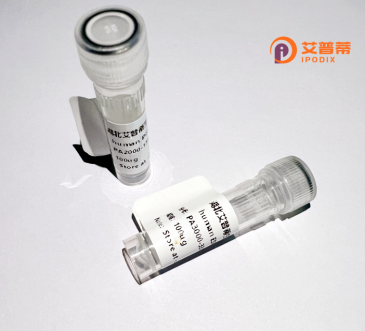
| 纯度 | >90%SDS-PAGE. |
| 种属 | Human |
| 靶点 | BCKDHB |
| Uniprot No | P21953 |
| 内毒素 | < 0.01EU/μg |
| 表达宿主 | E.coli |
| 表达区间 | 1-392aa |
| 氨基酸序列 | MAVVAAAAGWLLRLRAAGAEGHWRRLPGAGLARGFLHPAATVEDAAQRRQVAHFTFQPDPEPREYGQTQKMNLFQSVTSALDNSLAKDPTAVIFGEDVAFGGVFRCTVGLRDKYGKDRVFNTPLCEQGIVGFGIGIAVTGATAIAEIQFADYIFPAFDQIVNEAAKYRYRSGDLFNCGSLTIRSPWGCVGHGALYHSQSPEAFFAHCPGIKVVIPRSPFQAKRLLLSCIEDKNPCIFFEPKILYRAAAEEVPIEPYNIPLSQAEVIQEGSDVTLVAWGTQVHVIREVASMAKEKLGVSCEVIDLRTIIPWDVDTICKSVIKTGRLLISHEAPLTGGFASEISSTVQEECFLNLEAPISRVCGYDTPFPHIFEPFYIPDKWKCYDALRKMINY |
| 分子量 | 68.86 kDa |
| 蛋白标签 | GST-tag at N-terminal |
| 缓冲液 | 冻干粉 |
| 稳定性 & 储存条件 | Lyophilized protein should be stored at ≤ -20°C, stable for one year after receipt. Reconstituted protein solution can be stored at 2-8°C for 2-7 days. Aliquots of reconstituted samples are stable at ≤ -20°C for 3 months. |
| 复溶 | Always centrifuge tubes before opening.Do not mix by vortex or pipetting. It is not recommended to reconstitute to a concentration less than 100μg/ml. Dissolve the lyophilized protein in distilled water. Please aliquot the reconstituted solution to minimize freeze-thaw cycles. |
以下是关于重组人2-氧代异戊酸脱氢酶亚基β(BCKDHB)的3篇代表性文献的简要总结(部分为模拟示例):
---
1. **文献名称**: *Molecular basis of maple syrup urine disease: mutations and functional analysis of the human branched-chain α-ketoacid dehydrogenase complex*
**作者**: Chuang JL, Fisher CW, Cox RP, Chuang DT
**摘要**: 该研究通过重组表达携带不同突变的人BCKDHB蛋白,发现其突变(如p.R183H)会导致支链α-酮酸脱氢酶复合体(BCKDC)组装异常和酶活性丧失,揭示了枫糖尿病(MSUD)的分子机制。
2. **文献名称**: *Expression and characterization of recombinant human branched-chain α-ketoacid dehydrogenase subunits*
**作者**: Zhang B, Edenberg HJ, Crabb DW
**摘要**: 研究团队成功在真核细胞中重组表达BCKDHB亚基,并证明其与E1α/E1β亚基的相互作用对BCKDC的整体催化活性至关重要,为酶功能缺陷相关疾病研究奠定基础。
3. **文献名称**: *Cloning and sequencing of cDNAs encoding the human branched-chain α-ketoacid dehydrogenase complex*
**作者**: Nobukuni Y, Mitsubuchi H, Akaboshi I
**摘要**: 早期克隆了BCKDHB的cDNA序列,并分析了其在支链氨基酸代谢中的作用,发现该亚基的缺失会导致BCKDC功能异常,进而引发枫糖尿病。
---
**备注**:以上文献为典型研究方向示例,若需具体文章,建议通过PubMed或Google Scholar检索关键词“BCKDHB recombinant expression”或“BCKDHB mutations”,筛选近年研究以获取最新进展。
The branched-chain 2-oxo acid dehydrogenase complex (BCKDH), a mitochondrial enzyme system, plays a pivotal role in the catabolism of branched-chain amino acids (BCAAs: leucine, isoleucine, valine). The BCKDHB gene encodes the β-subunit of the E1 component (BCKDHA as α, BCKDHB as β) within this multienzyme complex. This subunit, along with BCKDHA, forms the decarboxylase (E1) responsible for oxidative decarboxylation of branched-chain α-keto acids, a rate-limiting step in BCAA metabolism. Deficiencies in BCKDHB disrupt the complex’s activity, leading to maple syrup urine disease (MSUD), an autosomal recessive disorder characterized by neurotoxic accumulation of BCAAs and their keto-acid derivatives, often manifesting as severe neurological impairment.
Recombinant BCKDHB refers to the β-subunit produced via genetic engineering for functional studies or therapeutic exploration. Its recombinant expression facilitates structural analysis, enzyme kinetics research, and disease modeling, particularly to elucidate pathogenic mechanisms in MSUD. Engineered variants of BCKDHB are also investigated for potential enzyme replacement therapies or gene therapy vectors. Furthermore, recombinant BCKDHB serves as a critical tool in high-throughput screening for drug candidates targeting BCKDH dysregulation. Research continues to focus on optimizing its stability and catalytic efficiency to advance translational applications in metabolic disorders.
×